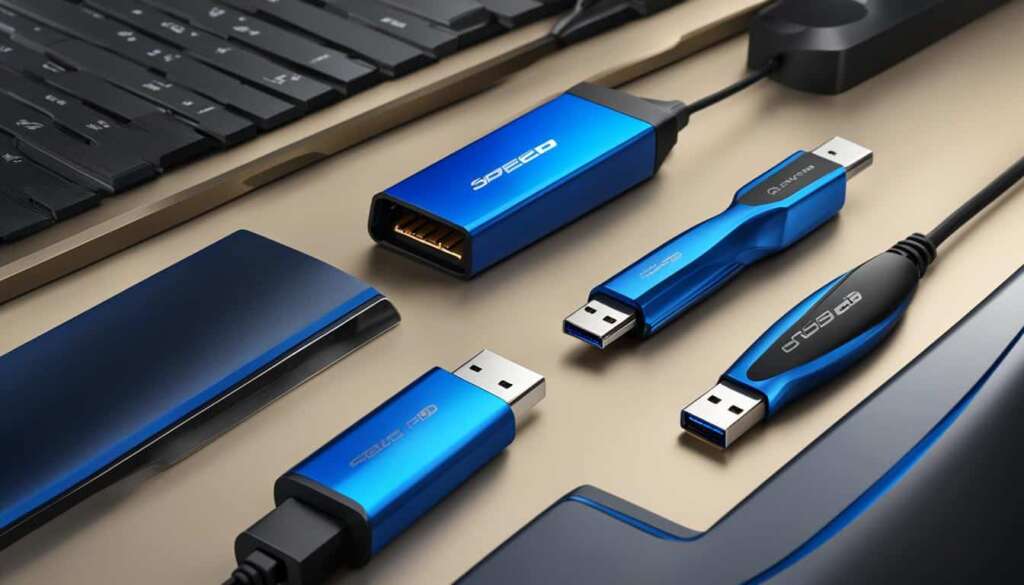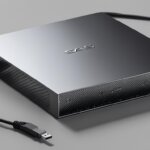Table of Contents
USB 3.0 is the third iteration of the Universal Serial Bus (USB) standard that was first introduced in 1996 to provide a standardised connection for various computer peripherals. USB 3.0 offers several advancements in data transfer technology that makes it faster and more efficient compared to previous versions.
USB 3.0 greatly enhances data transfer speeds by offering a transfer rate of up to 5 gigabytes per second (Gbps), which is almost 10 times faster than the previous USB 2.0 standard. It is also backwards-compatible with USB 2.0 devices, allowing devices to interoperate with no loss of functionality or features.
Key Takeaways
- USB 3.0 is the third version of the Universal Serial Bus standard.
- It provides faster data transfer speeds than USB 2.0.
- USB 3.0 is backward-compatible with USB 2.0.
- USB 3.0 devices can interoperate with no loss of functionality or features.
- USB 3.0 is a significant improvement over previous USB standards and offers several key advantages that make it popular in modern computing and peripheral connectivity.
The Evolution of USB Technology
The history of USB technology spans several decades and has undergone remarkable evolution. Introduced in the mid-1990s, USB 1.1 was a significant improvement over its predecessors. However, its data transfer speed was limited to 12Mbps, making it less efficient for transferring large files.
In 2000, USB 2.0 was released, offering faster data transfer speeds of up to 480Mbps, and it remained the dominant standard for many years. USB 2.0 enabled the connection of various devices, including printers, scanners, and cameras.
| USB Version | Introduced | Maximum Data Transfer Speed |
|---|---|---|
| USB 1.1 | 1998 | 12Mbps |
| USB 2.0 | 2000 | 480Mbps |
| USB 3.0 | 2008 | 5Gbps |
However, with the rapid increase in data transfer requirements, a new standard was inevitable, and that came in the form of USB 3.0. In 2008, USB 3.0 hit the market, providing ten times faster data transfer speeds than USB 2.0, peaking at 5Gbps.
“USB 3.0 is the natural progression of the best I/O interconnect the world has ever known.” – Jeff Ravencraft
USB 3.0 technology has facilitated the development of high-speed peripherals, including external hard drives, flash drives, cameras, and more, making it easier to transfer larger amounts of data faster than ever before.
Key Features and Advantages of USB 3.0
USB 3.0 is an advanced technology that offers many advantages over USB 2.0. Some of the key features of USB 3.0 are:
- Higher data transfer speeds: USB 3.0 can transfer data at up to 5Gbps, which is 10 times faster than USB 2.0.
- Increased power delivery: USB 3.0 can deliver up to 900mA of power, compared to the 500mA of USB 2.0.
- Backward compatibility: USB 3.0 devices are compatible with USB 2.0 ports, providing a seamless transition to the latest technology.
- Dual-bus architecture: USB 3.0 devices can simultaneously transmit and receive data, while USB 2.0 devices can only do one at a time.
- Less time to sync: With USB 3.0, syncing devices such as smartphones and music players is significantly faster, saving precious time.
One of the main advantages of USB 3.0 is its faster data transfer speeds. This is particularly useful for tasks such as transferring large files or backing up data. The increased power delivery capabilities of USB 3.0 also offer a range of benefits, such as faster charging times for devices and the ability to power more demanding peripherals.
Moreover, the backward compatibility of USB 3.0 means that users can still use their older devices while also taking advantage of the latest technology. This ensures that USB 3.0 devices are not only powerful but also highly versatile and user-friendly.
Conclusion
USB 3.0 is a significant advancement in USB technology, offering faster data transfer speeds, increased power delivery capabilities, and backward compatibility with USB 2.0. It offers significant advantages for modern computing and peripheral connectivity, making it an essential component for any computer setup.
As technology continues to evolve and demand for faster data transfer increases, the significance of USB 3.0 is undeniable. Its features and advantages make it the ideal choice for high-performance computing.
In conclusion, USB 3.0 is a game-changer in USB technology, and its importance in modern computing cannot be overstated. It is a must-have for anyone seeking faster data transfer and enhanced connectivity capabilities.
FAQ
What is USB 3.0?
USB 3.0 is the latest version of the Universal Serial Bus (USB) technology, designed to provide faster data transfer speeds and improved power delivery compared to its predecessors.
How does USB 3.0 differ from previous USB versions?
USB 3.0 offers significant advancements over previous USB versions. The most notable difference is the enhanced data transfer speed, which can reach up to 5 gigabits per second (Gbps) in USB 3.0 compared to 480 megabits per second (Mbps) in USB 2.0. USB 3.0 also allows for increased power delivery, enabling faster charging of devices.
Is USB 3.0 backward compatible with USB 2.0?
Yes, USB 3.0 is backward compatible with USB 2.0. This means you can still use USB 2.0 devices with a USB 3.0 port, but the data transfer speed will be limited to the capabilities of the USB 2.0 device.
Can I use a USB 3.0 cable with a USB 2.0 port?
Yes, you can use a USB 3.0 cable with a USB 2.0 port. The cable will still work, but the data transfer speed will be limited to the capabilities of the USB 2.0 port.
What are the benefits of using USB 3.0?
The benefits of USB 3.0 include faster data transfer speeds, quicker charging of devices, and improved power delivery capabilities. USB 3.0 also allows for simultaneous data transfer and power delivery, making it ideal for devices that require high-speed data transfer and power supply.













